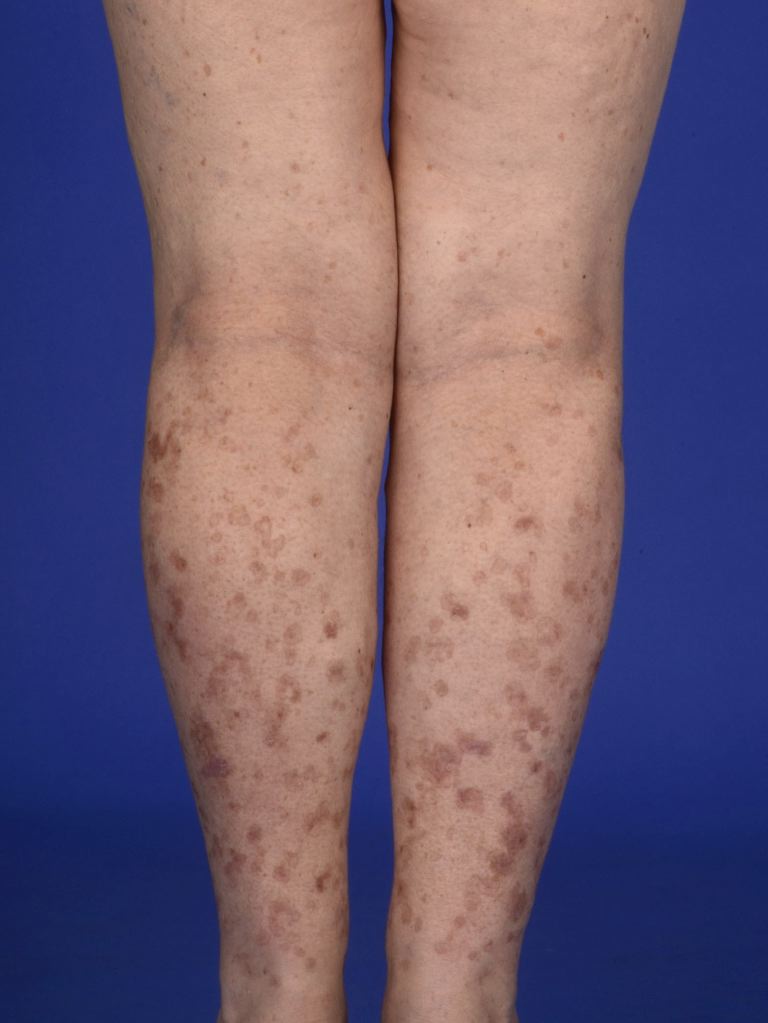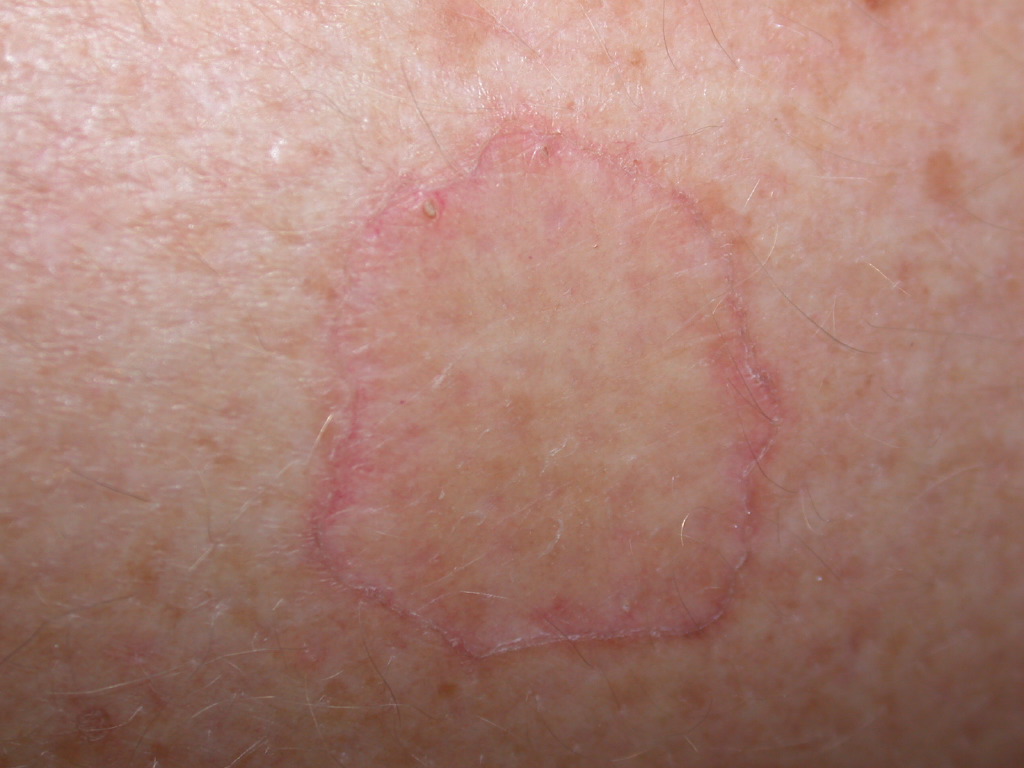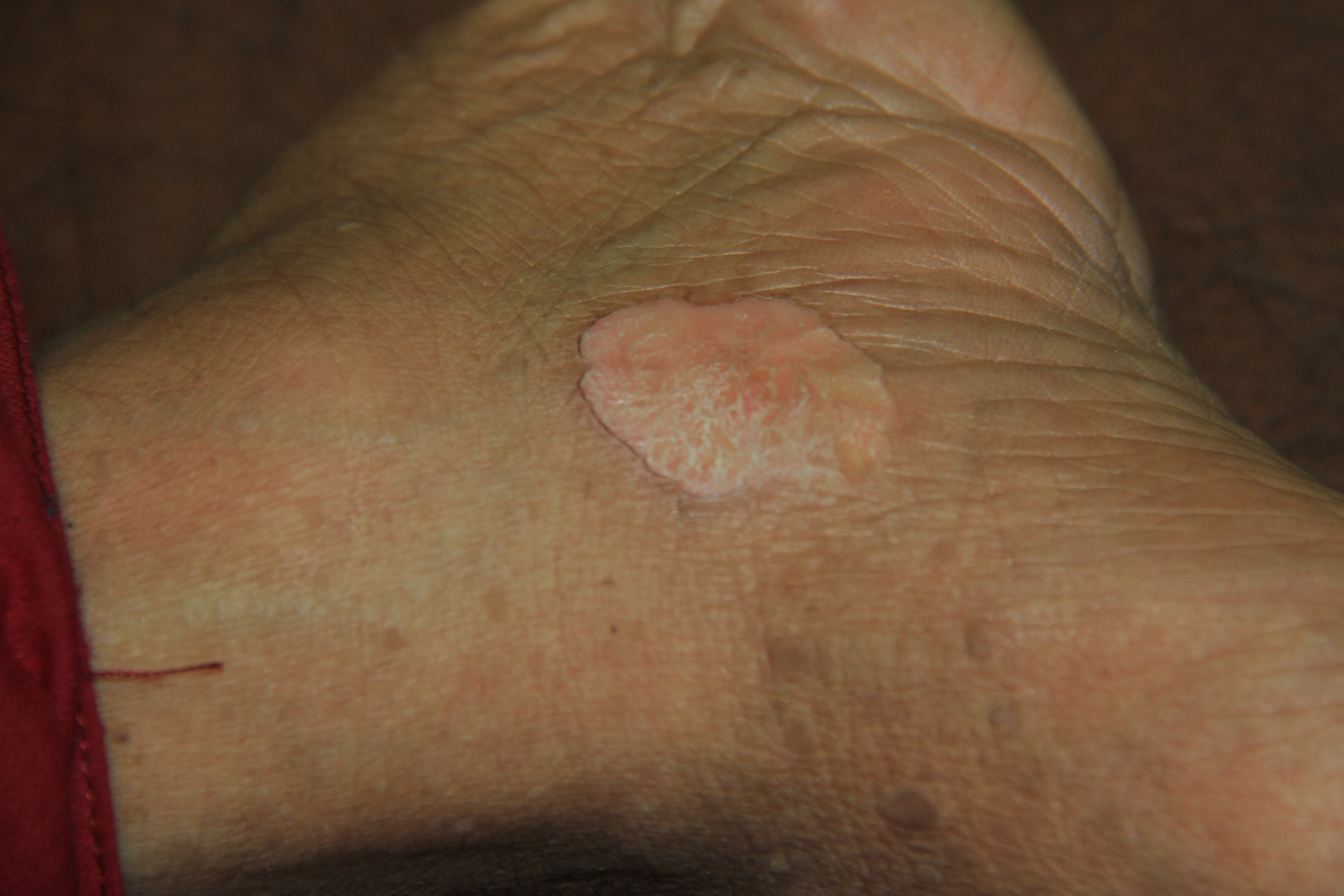[1]
Joshi R, Minni K. Genitogluteal porokeratosis: a clinical review. Clinical, cosmetic and investigational dermatology. 2018:11():219-229. doi: 10.2147/CCID.S143085. Epub 2018 May 1
[PubMed PMID: 29750048]
[2]
Leow YH, Soon YH, Tham SN. A report of 31 cases of porokeratosis at the National Skin Centre. Annals of the Academy of Medicine, Singapore. 1996 Nov:25(6):837-41
[PubMed PMID: 9055013]
Level 3 (low-level) evidence
[3]
Sertznig P, von Felbert V, Megahed M. Porokeratosis: present concepts. Journal of the European Academy of Dermatology and Venereology : JEADV. 2012 Apr:26(4):404-12. doi: 10.1111/j.1468-3083.2011.04275.x. Epub 2011 Sep 20
[PubMed PMID: 21929548]
[5]
Kanitakis J. Porokeratoses: an update of clinical, aetiopathogenic and therapeutic features. European journal of dermatology : EJD. 2014 Sep-Oct:24(5):533-44. doi: 10.1684/ejd.2014.2402. Epub
[PubMed PMID: 25115203]
[6]
Ahmed A, Hivnor C. A case of genital porokeratosis and review of literature. Indian journal of dermatology. 2015 Mar-Apr:60(2):217. doi: 10.4103/0019-5154.152587. Epub
[PubMed PMID: 25814761]
Level 3 (low-level) evidence
[7]
Weidner T, Illing T, Miguel D, Elsner P. Treatment of Porokeratosis: A Systematic Review. American journal of clinical dermatology. 2017 Aug:18(4):435-449. doi: 10.1007/s40257-017-0271-3. Epub
[PubMed PMID: 28283894]
Level 1 (high-level) evidence
[8]
Gu CY, Zhang CF, Chen LJ, Xiang LH, Zheng ZZ. Clinical analysis and etiology of porokeratosis. Experimental and therapeutic medicine. 2014 Sep:8(3):737-741
[PubMed PMID: 25120591]
[9]
Vargas-Mora P, Morgado-Carrasco D, Fustà-Novell X. Porokeratosis: A Review of Its Pathophysiology, Clinical Manifestations, Diagnosis, and Treatment. Actas dermo-sifiliograficas. 2020 Sep:111(7):545-560. doi: 10.1016/j.ad.2020.03.005. Epub 2020 May 13
[PubMed PMID: 32401728]
[10]
Ghani H, Richards E, Truong TM, Rao BK, Zhang A. A Review of the Efficacy of Topical Statins for Treating Disseminated Superficial Actinic Porokeratosis. Journal of drugs in dermatology : JDD. 2023 Oct 1:22(10):1053-1057. doi: 10.36849/JDD.7540. Epub
[PubMed PMID: 37801522]
[11]
Lu JD, Mufti A, Sachdeva M, Rahat S, Lansang RP, Yeung J. Drugs associated with development of porokeratosis: A systematic review. Dermatologic therapy. 2021 Jan:34(1):e14560. doi: 10.1111/dth.14560. Epub 2020 Dec 1
[PubMed PMID: 33210788]
Level 1 (high-level) evidence
[12]
Murase J, Gilliam AC. Disseminated superficial actinic porokeratosis co-existing with linear and verrucous porokeratosis in an elderly woman: Update on the genetics and clinical expression of porokeratosis. Journal of the American Academy of Dermatology. 2010 Nov:63(5):886-91. doi: 10.1016/j.jaad.2009.07.038. Epub 2010 May 6
[PubMed PMID: 20451293]
[13]
Shin EJ, Gwak MJ, Jeong KH, Lee MH. Disseminated Superficial Actinic Porokeratosis in a Vitiligo Patient Undergoing Treatment with Long-Term Narrowband Ultraviolet B. Annals of dermatology. 2018 Apr:30(2):249-251. doi: 10.5021/ad.2018.30.2.249. Epub 2018 Feb 21
[PubMed PMID: 29606833]
[14]
Magalhães C, Costa M, Campainha S, Coelho A, César A. Histopathologic findings of drug-induced eruptive porokeratosis under nivolumab therapy. Journal of cutaneous pathology. 2023 Apr:50(4):298-300. doi: 10.1111/cup.14379. Epub 2023 Feb 7
[PubMed PMID: 36515632]
[15]
Frew JW, Parsi K. Adalimumab-induced porokeratosis. The Australasian journal of dermatology. 2015 Aug:56(3):e80-1. doi: 10.1111/ajd.12215. Epub
[PubMed PMID: 26201378]
[16]
Lee DE, Kaffenberger BH, Gru AA, Hamann D. Temozolomide-induced inflammation of disseminated superficial actinic porokeratosis. Dermatology online journal. 2018 Mar 15:24(3):. pii: 13030/qt25m6s6nc. Epub 2018 Mar 15
[PubMed PMID: 29634886]
[17]
Herranz P, Pizarro A, De Lucas R, Robayna MG, Rubio FA, Sanz A, Contreras F, Casado M. High incidence of porokeratosis in renal transplant recipients. The British journal of dermatology. 1997 Feb:136(2):176-9
[PubMed PMID: 9068727]
[18]
Kanitakis J, Euvrard S, Faure M, Claudy A. Porokeratosis and immunosuppression. European journal of dermatology : EJD. 1998 Oct-Nov:8(7):459-65
[PubMed PMID: 9854155]
[19]
Bednarek R, Ezra N, Toubin Y, Linos K, Mousdicas N. Eruptive disseminated porokeratosis associated with corticosteroid-induced immunosuppression. Clinical and experimental dermatology. 2015 Oct:40(7):753-6. doi: 10.1111/ced.12636. Epub 2015 Mar 18
[PubMed PMID: 25800103]
[20]
Pietkiewicz P, Korecka K, Salwowska N, Kohut I, Adhikari A, Bowszyc-Dmochowska M, Pogorzelska-Antkowiak A, Navarrete-Dechent C. Porokeratoses-A Comprehensive Review on the Genetics and Metabolomics, Imaging Methods and Management of Common Clinical Variants. Metabolites. 2023 Nov 26:13(12):. doi: 10.3390/metabo13121176. Epub 2023 Nov 26
[PubMed PMID: 38132857]
[21]
Niimi Y, Kawana S. Type 2 segmental manifestation of disseminated superficial actinic porokeratosis in a 7-year-old girl. European journal of dermatology : EJD. 2009 Jan-Feb:19(1):25-8. doi: 10.1684/ejd.2008.0567. Epub 2008 Dec 5
[PubMed PMID: 19059828]
[22]
Neumann RA, Knobler RM, Jurecka W, Gebhart W. Disseminated superficial actinic porokeratosis: experimental induction and exacerbation of skin lesions. Journal of the American Academy of Dermatology. 1989 Dec:21(6):1182-8
[PubMed PMID: 2584454]
[23]
Sasson M, Krain AD. Porokeratosis and cutaneous malignancy. A review. Dermatologic surgery : official publication for American Society for Dermatologic Surgery [et al.]. 1996 Apr:22(4):339-42
[PubMed PMID: 8624658]
[24]
Wade TR, Ackerman AB. Cornoid lamellation. A histologic reaction pattern. The American Journal of dermatopathology. 1980 Spring:2(1):5-15
[PubMed PMID: 7246969]
[25]
Zhao M, Sanusi T, Zhao Y, Huang C, Chen S. Porokeratosis with follicular involvement: report of three cases and review of literatures. International journal of clinical and experimental pathology. 2015:8(4):4248-52
[PubMed PMID: 26097620]
Level 3 (low-level) evidence
[26]
Marks S, Varma R, Cantrell W, Chen SC, Gold M, Muellenhoff M, Elewski B. Diclofenac sodium 3% gel as a potential treatment for disseminated superficial actinic porokeratosis. Journal of the European Academy of Dermatology and Venereology : JEADV. 2009 Jan:23(1):42-5. doi: 10.1111/j.1468-3083.2008.02943.x. Epub
[PubMed PMID: 18702625]
[27]
Darr-Foit S, Elsner P. [77-year-old female with persisting erythematous and scaly plaques on the extremities and upper trunk : Preparation for the medical specialist examination: Part 20]. Der Hautarzt; Zeitschrift fur Dermatologie, Venerologie, und verwandte Gebiete. 2018 Nov:69(Suppl 2):165-168. doi: 10.1007/s00105-018-4281-8. Epub
[PubMed PMID: 30374539]
[28]
Ramelyte E, Bylaite-Bucinskiene M, Dummer R, Imhof L. Successful Use of Grenz Rays for Disseminated Superficial Actinic Porokeratosis: Report of 8 Cases. Dermatology (Basel, Switzerland). 2017:233(2-3):217-222. doi: 10.1159/000478855. Epub 2017 Aug 18
[PubMed PMID: 28817832]
Level 3 (low-level) evidence
[29]
Ting S, Webster M. Grenz ray therapy in disseminated superficial actinic porokeratosis: A case series of 17 patients. The Australasian journal of dermatology. 2022 Feb:63(1):91-94. doi: 10.1111/ajd.13769. Epub 2021 Dec 14
[PubMed PMID: 34905626]
Level 2 (mid-level) evidence
[30]
Spelman L, Christie D, Kaminski A, Baker C, Supranowicz M, Sinclair R. Radiotherapy, Utilizing Volumetric Modulated Arc Therapy, for Extensive Skin Field Cancerization: A Retrospective Case Series Assessing Efficacy, Safety, and Cosmetic Outcomes at 12 Months After Treatment. Case reports in dermatology. 2022 Jan-Apr:14(1):31-38. doi: 10.1159/000521067. Epub 2022 Mar 10
[PubMed PMID: 35431855]
Level 2 (mid-level) evidence
[31]
Santa Lucia G, Snyder A, Lateef A, Drohan A, Gregoski MJ, Barton V, Elston DM. Safety and Efficacy of Topical Lovastatin Plus Cholesterol Cream vs Topical Lovastatin Cream Alone for the Treatment of Disseminated Superficial Actinic Porokeratosis: A Randomized Clinical Trial. JAMA dermatology. 2023 May 1:159(5):488-495. doi: 10.1001/jamadermatol.2023.0205. Epub
[PubMed PMID: 36947042]
Level 1 (high-level) evidence
[32]
Saki N, Ahramiyanpour N, Heiran A, Alipour S, Parvizi MM. Efficacy of topical dimethyl sulfoxide (DMSO) 50% solution vs tretinoin 0.5% cream in treatment of patients with primary macular amyloidosis: A split-side single-blinded randomized clinical trial. Dermatologic therapy. 2020 May:33(3):e13305. doi: 10.1111/dth.13305. Epub 2020 Mar 25
[PubMed PMID: 32160368]
Level 1 (high-level) evidence
[33]
Mu X, Li W, Zhang M, Yang C, Yang X, Li D, Ding Y. Successful Treatment of Eruptive Pruritic Papular Porokeratosis in the Elderly with Tofacitinib: A Case Report. Clinical, cosmetic and investigational dermatology. 2023:16():1741-1747. doi: 10.2147/CCID.S412495. Epub 2023 Jul 6
[PubMed PMID: 37435395]
Level 3 (low-level) evidence
[34]
Akino S, Okano T, Takeuchi S, Ariizumi Y, Kadono T, Miyagaki T. Complete pruritus relief by oren-gedoku-to in eruptive pruritic papular porokeratosis. The Journal of dermatology. 2021 Aug:48(8):e378-e379. doi: 10.1111/1346-8138.15947. Epub 2021 May 13
[PubMed PMID: 33982823]
[35]
Zhang WL, Huang D, Zhang W, Wu YD, Feng SY, Jiang YQ, Li CR. Eruptive pruritic papular porokeratosis. Postepy dermatologii i alergologii. 2021 Feb:38(2):167-169. doi: 10.5114/ada.2021.104293. Epub 2021 Mar 10
[PubMed PMID: 34408586]
[36]
Silver SG, Crawford RI. Fatal squamous cell carcinoma arising from transplant-associated porokeratosis. Journal of the American Academy of Dermatology. 2003 Nov:49(5):931-3
[PubMed PMID: 14576684]



